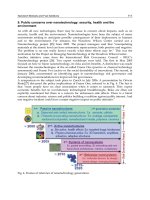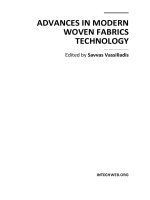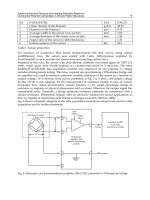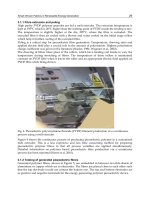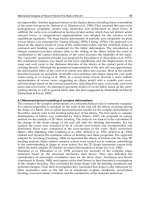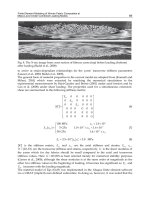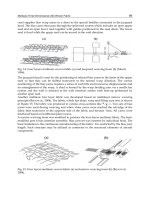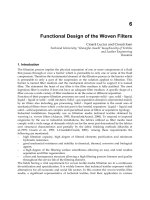Advances in Modern Woven Fabrics Technology Part 4 potx
Bạn đang xem bản rút gọn của tài liệu. Xem và tải ngay bản đầy đủ của tài liệu tại đây (4.6 MB, 20 trang )
Mechanical Analysis of Woven Fabrics:The State of the Art
49
incompressible. Another approach based on the elastica theory including linear extensibility
of the yarns was given by Dastoor et al. (Dastoor et al., 1994). They assumed the yarns to be
homogeneous, weightless slender rods, frictionless and undeformed by shear forces. In
addition the yarns were considered as having circular section which does not deform under
external forces. A computational implementation was adopted for the solution of the
equilibrium equations. The large biaxial deformation of partially and completely set plain
woven fabrics was presented by Huang (Huang, 1979b; Huang, 1979a). His approach was
based on the elastica model of yarns in the undeformed fabric and the combined action of
extension and bending was considered for the fabric deformation. The introduction of
bilinear moment-curvature relation (due to the sliding of the fibres within the yarn) in
combination to the contact deformation of the yarns increases the reliability of the study.
The “sawtooth” geometrical model was proposed by Kawabata et al. (Kawabata et al., 1973).
The mechanical analysis was based on the force equilibrium and the displacement of the
warp and weft yarns in the thickness direction of the fabrics at the contact point of the
crossing threads. Although the geometrical representation of the unit cell was approximant,
the deformation effect at the cross-over points was taken into account. Most of the models
described assume an unrealistic invariable cross-sectional yarn shape along the yarn path,
where Gong et al. (Gong et al. 2010), in a recent study moves towards a more realistic
representation of woven yarns, suggesting an ellipse model with a variable yarn cross-
sectional shape based on the various parameters, including fibre type, yarn count, yarn twist
factor and cover factor. An alternative geometric model of woven fabric, based on the yarns’
packing density as well as general fabric data, has been suggested by Dolatabadi and Kovař
(Dolatabadi & Kovař, 2009).
4.3 Mesomechanical modelling of complex deformations
The concept of the complex deformations on a mesomechanical scale is extremely marginal.
It is almost impossible to simulate on the scale of the unit cell the effects occurring during
the drape of a fabric. The so called mesomechanical models for the complex deformation of
the fabrics mainly refer to the bending behaviour of the fabrics. The first study in complex
deformations of fabrics was conducted by Peirce (Peirce, 1937). He proposed an energy
method for the analysis of 2D fabric bending. The analysis was based on the calculation of
the change of the strain energy of the unit cell after the bending deformation. For the
analysis the yarns were assumed to be of circular cross-section and incompressible and
distributed forces were considered at the cross-sections of the yarns. Many researchers
(Behre, 1961; Dahlberg, 1961; Lindberg et al., 1961; Abbott et al., 1971; Abbott et al., 1973)
studied and reported the nonlinear nature of bending and shear properties. The approach
adopted by Grosberg (Grosberg, 1966) incorporated the effects of friction into the strip 2D
bending analysis. Many relative research actions were carried out in continue contributing
to the understanding of drape to some extent. But the 2D drape assessment cannot fully
reflect the more complex 3D double curvature deformations of drape (Lo et al., 2002).
Shanahan et al. (Shanahan et al., 1978) accented the necessity of the complete drape
treatment based on the structural mechanics shell theory. They also defended the
consideration of anisotropic constitutive laws for the fabric sheet. Amirbayat and Hearle
(Amirbayat & Hearle, 1989) used aspects of the shell theory in their theoretical investigation
of the complex buckling. They correlated the drape shape with the bending, membrane and
potential energies. From their investigation they concluded that drape is also influenced by
other parameters such us the full set of anisotropic in-plane membrane, out-of-plane
bending, cross term elastic constants, and the nonlinearity of the materials behaviour.
Advances in Modern Woven Fabrics Technology
50
4.4 Macromechanical modelling of complex deformations
Many publications appeared in the past dealing with the macromechanical modelling of the
complex deformations of the fabrics. For many years this specific area has concentrated the
interest of many very important researchers. The most representative of them are referenced
below.
An approach of the elastica theory for the analysis of complex deformations of fibres and
fibre assemblies has been proposed by Konopasek (Konopasek, 1980a, 1980b, 1980c). It was
based on the concept of planar and spatial elastica as developed respectively by Euler and
Kirchhoff. Phenomena corresponding to the nonlinear behaviour of material, friction-
elasticity, elastic-plasticity, and visco-elasticity were introduced in the analysis. The planar
elastica theory was applied for the analysis of the large deflections of a yarn in a plane and
the cylindrical bending of a fabric treated as sheet material. The spatial elastica was applied
in the analysis of fibre buckling and crimp. The solution of the system of the resulted
nonlinear differential equations was supported by computational tools.
An alternative approach to the theoretical mechanics of static drape of fabrics based on the
differential geometry of surfaces was published by Lloyd et al. (Lloyd et al., 1996). They
developed a computationally convenient implementation of the theoretical mechanics of
fabrics. The fabrics themselves were treated as 2D continua represented by a surface without
considerable thickness embedded in the 3D Euclidean space. The mechanical properties of
the fabric were assigned to the model. The shape of the surface was described for both the
deformed and the undeformed state by the means of the differential geometry of the surface.
The strain values were deduced from the differences in the differential geometry
expressions for the two extreme states. The strain values were correlated to the applied
forces by the constitutive equations that express the mechanical properties of the material.
The differential geometry of surfaces for the dynamical modelling of fabric deformations
was used for the approach of the problem by J. and R. Postle (Postle & Postle, 1996). The
surface was considered as a series of twisted curves generated into the 3D Euclidean space.
The differential geometry parameters incorporated the mechanical properties of the material
(fabric) relating these mechanical properties to the changes in curvature as the surface was
transformed into another surface. The deformation of the surface from the initial state to the
final was mathematically modelled using the concept of homotopy. Bäcklund
transformations were chosen for the solution of the nonlinear partial differential equations
of the dynamic system.
Trying to combine the theoretical study to the experimental knowledge, Stump and Fraser
(Stump & Fraser, 1996) analyzed the drape of a circular fabric sample over the circular disk
of the drapemeter. They proposed an elastic ring-theory model of the draped fabric and
used an energy analysis associated with the various large post-buckled deformations of the
ring. Aim of their investigation was the study of the ability of the fabrics to present different
configurations when they are draped under exactly the same conditions. The explanation of
this ability was based on the calculation of the energy that corresponds to the various
symmetric configurations.
4.5 Evaluation of the analytical approaches
The review of the literature of the analytical methods for the mechanical analysis of textile
structures demonstrates the absence of a successful globally accepted technique suitable for
the textile design. The basic drawbacks of the analytical methods result from the simplifying
assumptions implemented in order to generate a low-complexity geometry and mechanical
Mechanical Analysis of Woven Fabrics:The State of the Art
51
problem. Thus the two-dimensional approach for the mesomechanical modelling, the
attribution of isotropic elastic properties in the yarn models, the assumption of linear and
isotropic properties in the macromechanical model introduces significant inaccuracies in the
textile modelling. However the basic disadvantage of analytical approaches is the difficulty
in handling in respect to the time consumption, the application field in terms of structures
and materials, and the integration of the individual stages (micro, meso, macro). On the
other side the analytical approaches accented the modelling difficulties of textile mechanics,
the basic considerations and roadmap for an integrated design procedure.
5. Numerical modeling
The enormous computational power arose from the development of the computer systems
and the expansion of advanced commercial software codes for the analysis of mechanical
problems was guiding the textile design towards the numerical approaches. Mainly the
Finite Element (FEM) and Boundary Element Method (BEM) were used for the mechanical
modelling of the textile structures (Hu & Teng, 1996).
5.1 Micro- and mesomechanical modelling of simple deformations
The first attempts in the computer based mesomechanics of textiles dealt with the 2D and
3D representation of the plain woven structure. The geometry proposed by Haas and then
by Peirce was the starting point for the solid geometrical modelling since the numerical
techniques succeed the solution of the complex system of equations. Keefe et al. (Keefe et al.,
1992) based on Peirce’s geometry presented the solid model of the plain woven fabric. They
also extended the model for various compactions and fabric angles. Later comparative
studies examined the accuracy of the geometrical models for use in the numerical modelling
of fabrics (Provatidis & Vassiliadis, 2002, 2004, Provatidis et al., 2005).
The first studies in mechanical analysis of textiles focused on the tensile deformation of the
plain woven unit cells. The initial use of computational methods in textile mechanics was
oriented towards the numerical solution of the complex analytical expressions. The use of
numerical methods, as FEM, BEM etc, for the achievement of a rigorous approach for the
textile micro- and mesomechanical analysis appeared in a later stage. Obstacles for the
successful use of numerical methods were mainly the large displacement effects and the
nonlinearity related with the deformations of textiles and the convergence problems arose.
Munro et al. (Munro et al., 1997a) proposed a new approach for the application of FEM to
the aligned fibre assembly problem. Three dimensional 8-node elements with cuboid shape
in the neutral configuration and 6 degrees of freedom (DOF) per node employed for the
investigation. The approach attempted to separate the various energy contributions to the
element stiffness, allowing the user to specify their properties individually. This technique
was successful in the easy introduction of nonlinear material properties in the solid model.
The approach of Munro et al. (Munro et al., 1997b) was verified qualitatively by modelling
realistic yarn situations. The yarn models were meshed by dividing them into layers where
the layer interfaces were surfaces perpendicular to the yarn axis. Each layer was split into a
number of finite elements ranging from 1 to 22. Initial configurations were arranged so that
the fibres within the elements followed idealized helical-yarn geometry. A multi-layer yarn
model consisting of 9 elements per layer was subjected to axial extension and axial
compression. The model presented the expected, in terms of quality, deformation behaviour.
Thus the necking of the yarn piece was caused by the helical winding of the fibres appeared
during extension. Moreover the elements of the model were opened significantly during the
Advances in Modern Woven Fabrics Technology
52
axial compressing test since the fibres were buckled to avoid compression of the fibre
material.
The advance and easy manipulation of CAD tools, in the last few years, allowed the
construction of 3D solid models of textile structures. By the use of the attributes of these
tools, such as numerical interpolations, mirroring abilities etc. the representation of the
structures became feasible. A yarn modelling approach based on the assumprion of helicoid
filaments of a constant helix radius and a circular filament cross-section for the loose and a
dense structure are presented in the Figure 8 and Figure 9 respectively.
Fig. 8. Beam model of filaments in random locations for loose yarn structure.
Fig. 9. Beam FE model of 50-filament twisted yarn (Vassiliadis et al., 2010).
Parametric solid modelling software packages are currently available allowing the
construction of complex woven structures (Figure 11). The complete design flexibility
provides the selection of weave pattern, yarn size or spacing. The yarn representation is still
based on the assumption of the homogenous material for the simplification of modelling
and the computational time saving (Toney, 2000). The advance moreover of the FEA codes
allowed the mechanical simulation of the unit cells of the modelled textile structures. The
mesomechanical modelling of textile structures was improved by the employment of
advanced finite elements types and libraries of material properties including linear,
nonlinear, elastic, plastic, viscoelastic, isotropic, orthotropic, anisotropic options etc.
Additionally the introduction of contact algorithms and large strain effects was essential for
the realistic results of the simulated tests. Lin et al. (Lin et al. 2008) studied the mechanical
behavior of woven fabrics under compression implementing the finite element analysis
using solid elements and nonlinear material properties. Furthermore, Durville (Durville,
2010) approached the textile simulation of woven structures’ problem at the fibres scale by
Mechanical Analysis of Woven Fabrics:The State of the Art
53
means of 3D beam model, providing interesting data useful in the incorporation of fibres in
composites structures.
Significant progress noticed in the modelling of complex structures of fabrics. Tarfaoui and
Akesbi (Tarfaoui & Akesbi, 2001) presented the model of the twill woven fabric and the
mechanical simulation using the FEM. The unit cell is composed by three warp yarns that
intersect with three weft yarns, presenting a different type of crimp. Furthermore, B-spline
curve methods have been successfully used to model woven yarns (Turan & Baser, 2010
Jiang & Chen, 2010).
Fig. 10. Solid FE model of unit cell of plain woven structure.
Fig. 11. Solid FE model of unit cell of twill (left) and satin (right) woven structure
(Vassiliadis et al., 2008).
Intensive researches were conducted in the field of woven fabrics composites due to their
progressive spread in industrial applications. Actually the exceptional characteristics of
woven fabrics composites, as high stiffness and strength, light-weight and efficient
manufacturability are determinant for their expansion in automotive, marine and aerospace
industry. Zhang and Harding presented one of the first numerical studies for the evaluation
of the elastic properties of the plain woven composite structures (Zhang & Harding, 1990).
Their approach was based on a strain energy method applied to a one-direction undulation
model using the FEM. The drawback of this approach, reported also by the authors, was the
consideration of the tow undulation in one-direction that is a non-realistic assumption for
woven fabrics. Naik expanded the above approach taking into account the strand cross-
section geometry, possible gap between two adjacent strands and the two-direction
undulation geometry (Naik & Ganesh, 1992). Actually his detailed model demands a large
Advances in Modern Woven Fabrics Technology
54
number of geometrical parameters to describe the undulation and varying thickness of the
tow structure. The evolution of numerical methods in the next years produced the first 3D
finite element models of the plain woven composites. Whitcomb studied the effect of
quadrature order, mesh density and material degradation on the predicted failure resulting
from the in-plain loading (Whitcomb & Srirengan, 1996).
The 3D solid modelling of the composite structure consists in the generation of the volumes
representing the woven unit cell and an external volume (with the apparent dimensions of
the composite unit cell). Then subtracting volumes of the woven structure from the external
volume, the volume of the matrix material is resulted (see figure 12).
Fig. 12. Geometrical model of composite woven structure (woven reinforcement, matrix,
composite)
Fig. 13. Geometrical model of a woven structure of tows and a composite structure.
Several approaches were based on the prediction of the homogenized elastic properties of
fabric composites using the unit cell of the composite structure. The geometrical
representation of the tows was based on certain assumptions such as circular, elliptic,
compressed hexagonal and lenticular cross-section areas were considered (Figure 13). The
used tows (usually made of glass or carbon fibres) were assumed as transverse isotropic
material and the matrix (usually resin) as isotropic material. The homogenized elastic
properties of the unit cell results from the mesomechanical analysis using FEM. A relative
approach proposed by Ng et al. (Ng et al., 1998) has ben applied for the prediction of the in-
plane elastic properties of a single layer 2/2 twill weave fabric composite. The compressed
hexagonal shape was considered for the tow cross-section. The modelling and mechanical
analysis was programmed using the ANSYS Parametric Design Language (APDL). The 8-
node solid elements with 3 degrees of freedom (translational) per node were used.
Mechanical Analysis of Woven Fabrics:The State of the Art
55
Indicatively a model of approximately 52000 finite elements and 12000 nodes was generated.
The contact areas generated during the subtracting operation (for the generation of matrix
material) were assigned to be shared entities for both the yarn and the matrix volumes, to
ensure the transmission of loading. Choi and Tamma (Choi & Tamma, 2001) dealt with the
prediction of the in-plane elastic properties of a composite structure reinforced with plain
woven fabric. The predicted elastic properties were used in continue for the damage
analysis of the laminated composite structures. The superposition principle was applied for
the evaluation of homogenised properties of the woven fabric composite. The generated
model of composite unit cells consists of 520 wedge elements for the yarns and 256 brick
elements for the matrix. The progressive damage was evaluated simulating the in-plane
tensile and shear deformation introducing a respective incrementing load. The degradation
of elastic moduli and Poisson ratios was considered for the mechanical damage analysis.
A main framework for the multi-scale modelling of woven composite structures for the
damage prediction was proposed by Kwon (Kwon, 1993, 2001; Kwon & Hamilton, 1995;
Kwon & Roach, 2004) and implemented in several following investigations. It is worth to
mention that the damage of a laminated textile composite is presented as a matrix damage,
fibre brakeage, fibre – matrix debonding or laminated debonding (delamination). The
proposed multi-scale approach is based on the integration of three individual modules: the
fibre-strand module, the strand-fabric module and the lamination module. The fibre-strand
module aims at the evaluation of the effective elastic properties of a unidirectional
composite strand exploiting the material properties and structure of the constituent fibres
and matrix. Moreover the current stage relates the stresses and strains of the strand with the
stresses and strains of the fibre and matrix materials thus the damage criteria can be applied.
The strand-fabric module focuses on the evaluation of the effective properties of the woven
fabric composite (unit cell) exploiting the material properties of the unidirectional composite
strand. In addition the current stage relates the stresses and strains of the composite
structure with the stresses and strains of the strand. Finally the lamination module evaluates
the effective properties of the laminated composite structure (multiple layer) using the
material properties of the composite lamina. A classical lamination theory or a higher order
theory is implemented in this stage. Thus the stresses and strains developed on the
laminated composite structure are correlated with the stresses and strains of the lamina.
An innovative research in the field of fabric composites is conducted in the K.U. Leuven,
initially focusing on the generalized description of the internal structure of the textile
reinforcement. Lomov and his colleagues developed a model for the internal geometry of
2D- and 3D-weaves based on a minimum number of topological data and yarn mechanical
properties. The mechanical model applies a yarn deformation energy minimization
algorithm to predict the internal geometry of any 2D- and 3D-weave. This approach was
systematically extended to 2D- and 3D-woven, two- and three-axial braided, weft knitted
and non-crimp warp-knit stitched fabrics and laminates and incorporated in the Wise-Tex
software package (Verpoest & Lomov, 2005; Lomov et al., 2000; Lomov et al., 2001).
Regarding the damage analysis of the composite structures a three-level hierarchy was
proposed: the micro-, meso- and macro-level. The micro-level defines the arrangement of
fibres in the representative volume of the impregnated yarn. The meso-level describes the
internal structure of the reinforcement and variations of the fibre direction and volume
fraction within the yarn. Finally the macro-level defines the 3D geometry of the composite
part and the distribution of the reinforcement properties.
Advances in Modern Woven Fabrics Technology
56
5.2 Macromechanical modelling of complex deformations
The macromechanical modelling of fabrics or cloth modelling, as usually referred, attracted
the interest of the textile community in the last decades. Many investigators attempted to
approach computationally the macromechanical performance of fabrics for several purposes
from the prediction of the drape behaviour of the fabric up to the virtual mode show (Gray,
1998). Depending on the purpose served and the application field different techniques were
developed. The basic classification of the developed techniques is divided into computer
animation models (graphic models) and the engineering design models. Many numerical
techniques including the particle-based model, the deformable node-bar model and the FEM
were developed for the engineering design of fabrics. Most of the efforts were focused on
the prediction of the drapeability of fabrics.
The used FEM for the drape simulation were based on a variety of element types from
simple rods to complex shell elements. Collier (Collier et al., 1991) studied the drape
behaviour of fabrics using a nonlinear FEM based on the classical nonlinear plate theory.
The fabric was assumed to be two dimensional. It was considered as a linear elastic material
with orthotropic anisotropy, where the symmetry lines are aligned in the warp and weft
directions. Many corrective actions were assigned the following years by the researchers in
the classical finite element techniques in order the realistic performance of fabrics to be
approached.
The FEM and flexible thin shell theory was employed by Chen and Govindaraj (Chen &
Govindaraj, 1995) to simulate the fabric drape. Their approach provides nonlinear solution
since large displacements appear during drape test. Thus the loads are applied
incrementally to the system, and at each step, the equilibrium equation system is solved by a
Newton-Raphson method. The nonlinearity was handled by calculating the stiffness matrix
in each step as a function of the displacement vector. The fabric was considered continuous
orthotropic material. A 9-node, doubly curved shell element with 5 DOF per node was used
for the simulation.
The simulation of the 3D drape test based on the FEM was also approached by Kang and Yu
(Kang & Yu, 1995). The woven fabric was assumed to be an elastic material with orthotropic
anisotropy. The fabric was considered as a thin flexible plate under the plane stress
condition, and the transverse shear strain was included in the formulation. Since large
displacements and large rotations are developed during draping, the drape phenomenon
was considered as geometrically nonlinear and respectively the nonlinear analysis was
adopted for the simulation. The Green-Lagrangian strains and the second Piolar-Kirchhoff
stresses were used for the analysis. The formulation of the FEM was based on a total
Lagrangian approach. 4-node quadrilateral elements were used with 5 DOF in each node. In
order to avoid the shear locking phenomenon which is commonly observed in the thin plane
analysis, a transverse shear strain interpolation method was applied. Almost the same
approach was proposed by Gan et al. (Gan et al., 1995). In their analysis 8-node shell
elements were used with 5 DOF per node. The adopted technique in this approach for the
elimination of locking was a reduced integration with zero energy mode control.
For the minimization of the computational power required for the simulation of fabric
drape, a FEM using simple beam elements with 6 DOF per node was proposed by Ascough
et al. (Ascough et al., 1996). The used beam elements include mass and stiffness properties
and can represent iso- or orthotropic cloth properties. The large displacement effects were
achieved with the addition of a geometric or initial stress matrix to the elastic stiffness
Mechanical Analysis of Woven Fabrics:The State of the Art
57
matrix to form the element characteristic matrix. Newmark’s method was used to allow a
time-stepping approach to the solution, with the advantage that the mesh geometry can be
updated at each step. The proposed analysis includes also interaction of the cloth with the
body form. Checks for a collision detection of material elements with the body model are
made following each time step of the drape simulation. An iterative calculation process is
executed until contact rather than penetration of cloth element with the body model occurs.
An approach for the drape simulation of woven fabrics quite different from the traditional
macromechanical methods was proposed by Breen et al. (Breen et al., 1994). The cloth was
modelled as a collection of particles that conceptually represent the crossing points of warp
and wefts threads in a plain weave. Important mechanical interactions that determine the
behaviour of woven fabric are discretized and lumped at these crossing points. The various
yarn-level structural constraints are represented with energy functions that capture simple
geometric relationships between the particles. These energy functions account for the four
basic mechanical interactions of yarn collision, yarn stretching, out of plane bending, and
trellising. The simulation was implemented as a three-phase process operating over a series
of discrete time steps. The first phase for a single time step calculates the dynamics of each
particle and accounts the collisions between particles and surrounding geometry. The
second phase performs an energy minimization to enforce inter-particle constraints. The
third phase corrects the velocity of each particle to account for particle motion during the
second phase.
Fig. 14. Deformed FE model of square fabric in drape test (Provatidis et al., 2009).
Stylios et al. (Stylios et al., 1995; Stylios et al., 1996) proposed a node-bar model for the drape
modelling of fabrics. The deformable elements were defined as consisting of one deformable
Advances in Modern Woven Fabrics Technology
58
node with a number of rigid bars. Thus the patch of cloth is divided into a grid (the patch is
divided as a series of elements, which can be of equal or unequal sizes). The material
properties of the continuum in all elements are lumped together at these deformable nodes
by integrating all the energies within those elements. The total energy density was
considered as the sum of strain, kinetic energy density, and the energy density introduced
by external and boundary forces. Viscoelastic terms were added in the energy equation. The
cloth motion in continue was determined using the Euler-Lagrange equations.
The finite volume method employed by Hu et al. (Hu et al., 2000) for the drape modelling of
fabrics. The mesh lines were aligned along the warp and weft direction producing
rectangular internal volumes and triangular or quadrilateral boundary volumes in a circular
fabric sheet. The equilibrium equations of the fabric sheet derived using the principle of
stationary total potential energy. Geometric nonlinearity and linear elastic orthotropic
material properties of the fabric were considered in the formulation. The full Newton-
Raphson iteration method with line searches was adopted for the solution of the resulting
nonlinear algebraic equation.
5.3 Evaluation of the numerical methods
The adoption of computational techniques in textile mechanics is essential to face and
overcome the objective difficulties, as the geometrical representation, the complex
deformations, the particular material properties, the contact phenomena and the large
deflection effects. Moreover, the advanced computer based tools are suitable for the virtual
representation of a product performance under loading. That is a significant facility for the
textile designers since a realistic sense from the mechanical up to the aesthetic attributes can
be provided.
Most of the mesomechanical modeling approaches implemented the finite element method
using solid FE. The yarns were assumed as homogenous material with transverse isotropic
elastic properties. The attribution of the yarn properties constitutes basic factor for the
accuracy of the mesomechanical modelling stage. Thus the equivalent performance of the
homogenous yarn, considering the discrete structure, in the tensile and bending
deformation is required at least for the reliable attribution of yarn models. It is remarkable
that most of the proposed models omitted the calculation of the real value of the yarn
bending rigidity and its attribution at the modelled yarn.
The macromechanical modelling approaches are grouped in two basic categories. The first
corresponds to the investigations based on the experimental measurement of the mechanical
properties of fabrics and the generation of equivalent models describing their bending
performance and drapeability (Collier et al., 1991; Ascough et al., 1996; Stylios et al., 1995;
Hu et al., 2000; Araujo et al., 2004). The second category focused on the computational
analysis of fabrics in the mesoscopic level and the generation of models presenting
equivalent in-plane elastic properties (Ng et al., 1998; Choi & Tamma, 2001; Lomov et al.,
2007).
The basic drawback encountered in the existing modelling approaches concerns the
collaboration of the different modelling stages (micro, meso, macro) for the development of
an integrated design procedure of the textile structures. Thus the modelling of the structure
in the mesoscopic level should incorporate the micromechanical performance of the yarns.
Whereas the modelling of the structure in the macroscopic level should incorporate the
mesoscopic performance of the unit cells and therefore the microscopic performance of the
Mechanical Analysis of Woven Fabrics:The State of the Art
59
yarns. Consequently the collaboration of the discrete modelling stages is attainable
generating realistic models and attributing the equivalent properties.
6. Conclusions
An extended review was conducted over the textile mechanical modelling area. It is obvious
that despite the about 70 years of actual research it’s not possible to conclude in an
Integrated Computer Aided Engineering Environment. The absence of a global tool was
remarked, that aggravates the textile design procedure in terms of time and cost.
The structural hierarchy of the textile structures (fibre – yarn – fabric) is correlated with the
high level of complexity presented in the modelling procedure and the mechanical analysis
of them. The difficulties are increased due to the high divergence of the dimensions
corresponding to the fabric sheet (10
-1
to 10
0
m) and the structural elements (fibre diameter,
10
-5
m). The modelling complexity resulted from the structural hierarchy of textiles is faced
adopting a relative modelling hierarchy. Thus three basic modelling scales were developed:
the micromechanical modelling of yarns, the mesomechanical modelling of the fabric unit
cell and the macromechanical modelling of the fabric sheet. The modular modelling of the
textile woven fabrics is a systematic method to overcome the complexity of the mechanical
structure and the nature of the materials involved. The global evolution of the modelling
approaches seem to converge in this stepwise method and thus indicate a likely way
towards the desired Textile Computer Aided Engineering environment.
7. References
Abbott, G.M., Grossberg, P. and Leaf, G.A.V., (1971) The mechanical properties of woven
fabrics, part VII: hysteresis and bending of woven fabrics. Textile Research Journal,
Vol.41, No.4, pp. 345-348.
Abbott, G.M., Grosberg, P. and Leaf, G.A.V., (1973) The elastic resistance to bending of
plain-woven fabrics. Journal of the Textile Institute, Vol.64, No.3), pp. 346-362.
Amirbayat, J. and Hearle, J.W.S., (1989) The anatomy of buckling of textile fabrics: Drape
and conformability of dimensionless groups. Journal of the Textile Institute, Vol.80,
pp. 51-70.
Araujo, M., Fangueiro, R. and Hong, H., (2004) Modelling and simulation of the mechanical
behaviour of weft-knitted fabrics for technical applications. Part IV: 3D FEA model
with a mesh of tetrahedric elements. Autex Research Journal, Vol.4, No.2, pp. 72-80.
Ascough, J., Bez, H.E. and Bricis, A.M., (1996) A simple beam element, large displacement
model for the finite element simulation of cloth drape. Journal of the Textile
Institute, Vol.87, No.1, pp. 152-165.
Backer, S., (1952) The mechanics of bent yarns. Textile Research Journal, 22(5), pp. 668-681.
Behre, B., (1961) Mechanical properties of textile fabrics, part I: Shearing. Textile Research
Journal, Vol.31, No.2), pp. 87-99.
Bogdanovich, A.E., (2006) Multi-scale modeling, stress and failure analyses of 3-D woven
composites. Journal of Materials Science, Vol.41, No.20), pp. 6547-6590.
Breen, D.E., House, D.H. and Wozny, M.J., (1994) Predicting the drape of woven cloth using
interacting particles. Computer Graphics, Vo.4, pp. 365-372.
Chen, B. and Govindaraj, M., (1995) Physically based model of fabric drape using flexible
shell theory. Textile Research Journal, Vol.65, No.6, pp. 324-330.
Advances in Modern Woven Fabrics Technology
60
Cho, G., Lee, S. and Cho, J., (2009) Review and reappraisal of smart clothing. International
Journal of Human-Computer Interaction, Vol.25, No.6, pp. 582-617.
Choi, J. and Tamma, K.K., (2001) Woven fabric composites, Part I: Predictions of
homogenized elastic properties and micromechanical damage analysis. Int. J.
Numer. Meth. Eng,Vol.50, pp. 2285-2298.
Choi, K.F. and Tandon, S.K., (2006) An energy model of yarn bending. Journal of the Textile
Institute, Vol.97, No1, pp. 49-56.
Collier, J.R., Collier, B.J., O'Toole, G. and Sargand, S.M., (1991) Drape prediction by means of
finite-element analysis. Journal of the Textile Institute, Vol.82, No1, pp. 96-107.
Dahlberg, B., (1961) Mechanical properties of textile fabrics Part II: Buckling. Textile
Research Journal, Vol.31, No.2, pp. 94-99.
Dastoor, P.H., Ghosh, T.K., Batra, S.K. and Hersh, S.P., (1994) Computer-assisted structural
design of industrial woven fabrics part III: modelling of fabric uniaxial/biaxial
load-deformation. Journal of the Textile Institute, Vol.85, No.2, pp. 135-137.
Dunne, E. L., Brady, S., Smyth, B. and Diamond, D., (2005) Initial development and testing
of a novel foam-based pressure sensor for wearable sensing. Journal of
NeuroEngineering and Rehabilitation, Vol.2, No.4, pp.1-7.
Freeston, W.D., Platt, M.M. and Schoppee, M.M., (1967) Mechanics of elastic performance of
textile materials. XVIII. Stress-strain response of fabrics under two-demensional
loading. Textile Research Journal, Vol.37, No.11, pp. 948-975.
Freeston, W.D. and Schoppee, M.M., (1975) Geometry of Bent Continuous-Filament Yarns.
Textile Research Journal, Vol.45, No.12, pp. 835-852.
Gan, L., Ly, N.G. and Steven, G.P., (1995) A study of fabric deformation using nonlinear
finite elements. Textile Research Journal, Vol.65, No.11, pp. 660-668.
Gray, S., (1998) In virtual fashion. IEEE Spectrum, Vol.35, No.2, pp. 18-25.
Grosberg, P., (1966) The mechanical properties of woven fabrics, Part II: The bending of
woven fabrics. Textile Research Journal, Vol.36, No.3, pp. 205-211.
Grosberg, P. and Kedia, S., (1966) The Mechanical Properties of Woven Fabrics, Part I: The
Initial Load Extension Modulus of Woven Fabrics. Textile Research Journal, Vol.36,
No.1, pp. 71-79.
Haas, R. and Dietzius, A. (1918) The stretching of the fabric and the shape of the envelope in
non-rigit ballons. Annual Report, Report No. 16, National Advisory Committee for
Aeronautics, pp.149-271 (originally published in German as: Haas, Rudolf und
Alexander Dietzius, Stoffdehnung und Formaenderung der Huelle bei Prall-
Luftschiffen. Untersuchungen im Luftschiffbau der Siemens-Schukkert-Werke,
1913, Luftfahrt und Wissenschaft, Hft. 4.)
Hearle, J.W.S., (2006) Engineering design of textiles. Indian Journal of Fibre and Textile
Research, Vol.31, No.1, pp. 134-141.
Hearle, J.W.S., El-Behery, H.M.A.E. and Thakur, V.M., (1959) The mechanics of twisted
yarns: Tensile properties of continuous-filament yarns. Journal of the Textile
Institute, Vol.50, pp. T83-T111.
Horrocks A. R. and Anand, S. C. (Eds.)(2000) Handbook of Technical Textiles, Woodhead
Publishing, 978-1-85573-385-5.
Mechanical Analysis of Woven Fabrics:The State of the Art
61
Hu, J. L., (2004) Structure and mechanics of woven fabrics, Woodhead Publishing Limited, 1
85573 904 6.
Hu, J., Chen, S and Teng, J.G., (2000) Numerical drape behavior of circular fabric sheets
over circular pedestals. Textile Research Journal, Vol.70, No.7, pp. 593-603.
Hu, J.L. and Teng, J.G., (1996) Computational fabric mechanics: Present status and future
trends. Finite Elements in Analysis and Design, Vol.21, No.4, pp. 225-237.
Huang, N.C., (1979a) Finite Biaxial Extension of Completely Set Plain Woven Fabrics.
Journal of Applied Mechanics, Transactions ASME, Vol.46, No.3, pp. 651-655.
Huang, N.C., (1979b) Finite biaxial extension of partially set plain woven fabrics.
International Journal of Solids and Structures, Vol.15, No.8, pp. 615-623.
Jayaraman, S., Kiekens, P. and Grancaric, A. M. (Eds). (2006). Intelligent Textiles for Personal
Protection and Safety, IOS Press Inc., 1586035991.
Kallivretaki, A., (2010) Three-dimensional micromechanical models of textile fabrics, PhD
Thesis, National Technical University of Athens.
Kang, T.J. and Yu, W.R., (1995) Drape simulation of woven fabric by using the finite-element
method. Journal of the Textile Institute, Vol.86, No.4, pp. 635-648.
Kawabata, S., Niwa, M. and Kawai, H., (1973) Finite-Deformation Theory of Plain-Weave
Fabrics - 1. The Biaxial-Deformation Theory. Journal of the Textile Institute, Vol.64,
No.1, pp. 21-46.
Keefe, M., Edwards, D.C. and Yang, J., (1992) Solid modeling of yarn and fiber assemblies.
Journal of the Textile Institute, Vol.83, No.2, pp. 185-196.
Kemp, A., (1958) An extension of Peirce's cloth geometry to the treatment of non-circular
threads. Journal of the Textile Institute, Vol.49, No.1, pp. T44-T48.
Komori, T., (2001) A generalized micromechanics of continuous-filament yarns part I:
Underlying formalism. Textile Research Journal, Vol.71, No.10, pp. 898-904.
Konopasek, M., (1980a) Classical elastica theory and its generalizations. In: J.W.S. Hearle, J.J.
Thwaites and J. Amirbaya, eds, Mechanics of flexible fibre assemblies, Nato
Advanced Study Institutes Series, Series E: Applied Science - No. 38. USA: Sijthoff
& Noordhoff, pp. 255-274.
Konopasek, M., (1980b) Computational aspects of large deflection analysis of slender bodies.
In: J.W.S. Hearle, J.J. Thwaites and J. Amirbaya, eds, Mechanics of flexible fibre
assemblies, Nato Advanced Study Institutes Series, Series E: Applied Science - No.
38. USA: Sijthoff & Noordhoff, pp. 275-292.
Konopasek, M., (1980c) Textile application of slender body mechanics. In: J.W.S. Hearle, J.J.
Thwaites and J. Amirbaya, eds, Mechanics of flexible fibre assemblies, Nato
Advanced Study Institutes Series, Series E: Applied Science - No. 38. USA: Sijthoff
& Noordhoff, pp. 293-310.
Kwon, Y.W., (1993) Calculation of effective moduli of fibrous composites with micro-
mechanical damage. Composite Structures, Vol.25, No.1-4, pp. 187-192.
Kwon, Y.W., (2001) Multi-level approach for failure in woven fabric composites. Advanced
Engineering Materials, Vol.3, No.9, pp. 713-717.
Kwon, Y.W. and Hamilton, B.H., (1995) Micro/macro-analysis of damage evolution in plate
bending of composites. Proceedings of the 1995 ASME International Mechanical
Advances in Modern Woven Fabrics Technology
62
Engineering Congress and Exposition; San Francisco, CA, USA; November 1995,
Vol.321,pp. 1-9.
Kwon, Y.W. and Roach, K., (2004) Unit-cell model of 2/2-twill woven fabric composites for
multi-scale analysis. CMES - Computer Modeling in Engineering and Sciences,
Vol.5, No.1, pp. 63-72.
Lindberg, J., Behre, B. and Dahlberg, B., (1961) Mechanical properties of textile fabrics, Part
III: Shearing and buckling of various commercial fabrics. Textile Research Journal,
Vol.31, No.2, pp. 99-122.
Lloyd, D.W., Mete, F. and Hussain, K., (1996) An approach to the theoretical mechanics of
static drape. International Journal of Clothing Science and Technology, Vol.8, No.3,
pp. 43-58.
Lo, W.M., Hu, J.L. and Li, L.K., (2002) Modeling a fabric drape profile. Textile Research
Journal, Vol.72, No.5, pp. 454-463.
Lomov, S.V., Gusakov, A.V., Huysmans, G., Prodromou, A. and Verpoest, I., (2000) Textile
geometry preprocessor for meso-mechanical models of woven composites.
Composites Science and Technology, Vol.60, No.11, pp. 2083-2095.
Lomov, S.V., Huysmans, G., Luo, Y., Parnas, R.S., Prodromou, A., Verpoest, I. and Phelan,
F.R., (2001) Textile composites: Modelling strategies. Composites - Part A: Applied
Science and Manufacturing, Vol.32, No.10, pp. 1379-1394.
Lomov, S.V., Ivanov, D.S., Verpoest, I., Zako, M., Kurashiki, T., Nakai, H. and Hirosawa, S.,
(2007) Meso-FE modelling of textile composites: Road map, data flow and
algorithms. Composites Science and Technology, Vol.67, No.9, pp. 1870-1891.
Munro, W.A., Carnaby, G.A., Carr, A.J. and Moss, P.J., (1997a) Some Textile Applications of
Finite-element Analysis. Part I: Finite Elements for Aligned Fibre Assemblies.
Journal of the Textile Institute, Vol.88, No.4, pp. 325-338.
Munro, W.A., Carnaby, G.A., Carr, A.J. and Moss, P.J., (1997b) Some Textile Applications of
Finite-element Analysis. Part II: Finite Elements for Yarn Mechanics. Journal of the
Textile Institute, Vol.88, No.4, pp. 339-351.
Naik, N.K. and Ganesh, V.K., (1992) Prediction of on-axes elastic properties of plain weave
fabric composites. Composites Science and Technology, Vol.45, No.2, pp. 135-152.
Ng, S , Tse, P and Lau, K , (1998) Numerical and experimental determination of in-plane
elastic properties of 2/2 twill weave fabric composites. Composites Part B:
Engineering, Vol.29 No.6, pp. 735-744.
Olofsson, B., (1964a) A general model of a fabric as a geometric-mechanical structure.
Journal of the Textile Institute, Vol.55, No.11, pp. T541-T557.
Olofsson, B., (1964b) The Setting of Wool Fabrics - A Theoretical Study. Journal of the Textile
Institute, Vol.20, pp. 272-273.
Önder, E. and Bacer, G., (1996) A comprehensive stress and breakage analysis of staple fiber
yarns Part I: Stress analysis of a staple yarn based on a yarn geometry of conical
helix fiber paths. Textile Research Journal, Vol.66, No.9, pp. 562-575.
Park, J and Oh, A , (2006) Bending rigidity of yarns. Textile Research Journal, Vol.76,
No.6, pp. 478-485.
Parsons, E. M., Weerasooriya, T., Sarva, S. and Socrate, S., (2010) Impact of woven fabric:
Experiments and mesostructure-based continuum-level simulations. Journal of the
Mechanics and Physics of Solids, Vol.58, pp. 1995-2021.
Mechanical Analysis of Woven Fabrics:The State of the Art
63
Peirce, F.T., (1937) The geometry of cloth structure. Journal of the Textile Institute, Vol.28,
No. T45, pp.43-77.
Platt, M.M., Klein, W.G. and Hamburger, W.J., (1959) Mechanics of elastic performance of
textiles materials, part XIV: Some aspects of bending rigidity of single yarns. Textile
Research Journal, Vol.29, pp. 611.
Postle, J.R. and Postle, R., (1996) Modelling fabric deformation as a nonlinear dynamical
system using Bäcklund Transformations. International Journal of Clothing Science
and Technology, Vol.8, No.3, pp. 22-42.
Provatidis, C. and Vassiliadis, S., (2002) On the numerical estimation of the mechanical
behaviour of fabrics, 2nd AUTEX World Textile Conference, 2002, , pp. 88-97.
Provatidis, C.G. and Vassiliadis, S.G., (2004) On the performance of the geometrical models
of fabrics for use in computational mechanical analysis. International Journal of
Clothing Science and Technology, Vol.16, No.5, pp.434-444.
Provatidis, C.G., Vassiliadis, S.G. and Anastasiadou, E.A., (2005) Contact mechanics in two-
dimensional finite element modelling of fabrics. International Journal of Clothing
Science and Technology, Vol.17, No.1, pp.29-40.
Provatidis, C., Kallivretaki, A. and Vassiliadis, S., (2009) Fabric Drape Simulation using
FEM, Proceedings of the South-East European Conference on Computational
Mechanics, SEECCM, Rhodes, Greece, June 2009.
Shanahan, W.J., Lloyd, D.W. and Hearle, J.W.S., (1978) Characterizing the elastic behaviour
of textile fabrics in complex deformation. Textile Research Journal, Vol.48, pp. 495-
505.
Stump, D.M. and Fraser, W.B., (1996) A simpified model of fabric drape based on ring
theory. Textile Research Journal, Vol.66, No.8, pp. 506-514.
Stylios, G., Wan, T.R. and Powell, N.J., (1995) Modeling the dynamic drape of fabrics on
synthetic humans, a physical, lumped-parameter model. Int. J. Clothing Sci.
Technol., Vol.7, No.5, pp. 10-25.
Stylios, G.K., Wan, T.R. and Powell, N.J., (1996) Modelling the dynamic drape of garments
on synthetic humans in a virtual fashion show. International Journal of Clothing
Science and Technology, Vol.8, No.3, pp. 95-112.
Takano, N., Uetsuji, Y., Kashiwagi, Y. and Zako, M., (1999) Hierarchical modelling of textile
composite materials and structures by the homogenization method. Modelling and
Simulation in Materials Science and Engineering, Vol.7, No.2, pp. 207-231.
Tang, S. L. P., (2007) Recent developments in flexible electronics for monitoring applications.
Transactions of the Institute of Measurement and Control, Vol.29, pp. 283-300.
Tarfaoui, M. and Akesbi, S., (2001) Numerical study of the mechanical behaviour of textile
structures. International Journal of Clothing Science and Technology, Vol.13, No.3-
4, pp. 166-175.
Toney, M.M., (2000) Computer modeling of fibrous structures. Journal of the Textile
Institute, Vol.91, No.3, pp. 133-139.
Tognetti, L. A., Carbonaro, N., Zupone, G. and De Rossi, D., (2006) Characterization of novel
data glove based on textile integrated sensors. Proceedings of the 28th IEEE, EMBS
Annual International Conference, pp.2510-2513.
Vassiliadis, S., Kallivretaki, A., Grancaric, A.M., Giannakis, S. and Provatidis, C., (2008)
Computational modelling of twill and satin woven structure, Proc. of the World
Conference AUTEX 2008, June 2008, Biella, Italy.
Advances in Modern Woven Fabrics Technology
64
Vassiliadis, S., Kallivretaki, A. and Provatidis, C., (2010) Mechanical modelling of
multifilament twisted yarns. Fibers and Polymers, Vol.11, No.1, pp. 89-96.
Verpoest, I. and Lomov, S.V., (2005) Virtual textile composites software WiseTex: Integration
with micro-mechanical, permeability and structural analysis. Composites Science
and Technology, Vol.65(15-16 SPEC. ISS.), pp. 2563-2574.
Whitcomb, J. and Srirengan, K., (1996) Effect of various approximations on predicted
progressive failure in plain weave composites. Composite Structures, Vol.34, No.1,
pp. 13-20.
Xu, P.J., Zhang, H. and Tao, X.M., (2008) Textile-structured electrodes for electrocardiogram.
Textile Progress, Vol.40, No.4, pp. 183-213.
Zhang, Y.C. and Harding, J., (1990) A numerical micromechanics analysis of the mechanical
properties of a plain weave composite. Computers & Structures, Vol.36, No.5, pp.
839-844.
4
Finite Element Modeling of Woven Fabric
Composites at Meso-Level Under
Combined Loading Modes
Mojtaba Komeili and Abbas S. Milani
School of Engineering, University of British Columbia,
Canada
1. Introduction
Woven fabrics are among the most important materials used in today’s modern industries.
Next to their high mechanical properties, they are easy to handle in the dry or pre-
impregnated pre-forms, offer good drape-ability and are particularly suited for
manufacturing of doubly curved components, membranes, inflatable structures, etc
(Cavallaro et al., 2003; 2007). In the dry form, fabrics can be formed into a variety of three-
dimensional (3D) shapes and then consolidated with resin via resin transfer molding (RTM)
or other manufacturing processes (Boisse et al., 2007). Reliable models capable of predicting
the mechanical behaviour of woven fabric materials are not fully developed yet. The biggest
challenge in this regard is perhaps the multi-scale nature of the fabric materials. Dry fabrics
at macro level are composed of numerous yarns interlaced into each other. The yarns
usually have characteristic length in the scale of millimetres and their interaction and
behaviour at the fabric level can greatly influence the macro-level material behaviour
(Guagliano and Riva, 2001). Yarns themselves are heterogeneous media made of bundles of
very thin and long fibers. Figure 1 shows different hierarchical levels in a woven fabric
along with their typical dimensions.
Micro‐level
fibers
~10
‐6
m
Macro‐level
part
~10
0
m
Meso‐level
yarns
~10
‐3
m
Fig. 1. 3 Hierarchical levels in woven fabrics
Advances in Modern Woven Fabrics Technology
66
Among different material scales, meso-level modeling of woven fabrics is known to be a
strong tool for predicting their effective mechanical properties at macro-level (Peng and
Cao, 2002). It can also be useful for studying their local deformation mechanisms that occur
during different manufacturing processes and loading conditions. Of different modeling
techniques, the 3D finite element modeling is found to be of great interest to the researchers
in the field. However, the multi-scale nature of fabrics makes the applicable numerical
procedures different from those of the conventional finite element method. The fact that
fabric yarns are heterogeneous media formed by bundles of fibres, and that the loose
bounding between fibers in each yarn allows them to slide on each other, makes a
considerable distinction in postulating the yarns’ constitutive models as well as the
numerical procedures applied to analyze their deformation.
(Kawabata et al., 1973; 1973a; 1973b) presented general theories for modeling woven fabric
unit cells using bar and stiffness elements. Their sample model was based on the
geometrical simplifications on a unit cell along with some parameters that were determined
from experiments. Boisse et al., (1997) used the above model and developed a finite element
simulation of a dry fabric forming process. Bi-axial tension tests were used to identify the
unknown parameters in the constitutive model of the fabric unit cell. In order to develop
more accurate models with more insight towards the local deformation phenomena in fibre
yarns, Gasser et al. (2000) developed a 3D finite element model of a unit cell under bi-axial
tension. Their results were compared to a set of bi-axial tests and satisfactory agreements
were obtained. One of the most important features in their approach was to link the meso-
level material model to the micro-level behaviour of yarns. For example, quasi-zero shear
modulus and Poisson’s ratio, crushing transverse behaviour of yarns, and the update of
direction of material orientation during deformation were taken into account. Later on, the
model was extended to simulate the in-plane shear behaviour of dry fabrics (Badel et al.,
2007) and an algorithm for implementing a hypoelastic constitutive model was presented by
Badel et al. (2008; 2009). For implementation of these models in numerical packages, the
explicit solver of Abaqus has been frequently used. Recently, Komeili and Milani (2010)
used a modified version of the aforementioned algorithm to implement an implicit
integrator in Abaqus, which led to an increased accuracy and significantly decreased the
simulation run time.
Based on the brief review above, it appears that the meso-level finite element modeling of
fabrics has been mostly based on individual axial tension and shear modes. Other
researchers have also looked at the homogenization of yarn properties at micro/meso levels,
but again under individual deformation modes (Chen et al., 2001; Peng and Cao, 2002).
Similarly, at macro-level, Xue et al. (2003), followed by Peng and Cao (2005), developed a
constitutive material model for the dry fabric sheets. The model was based on a non-
orthogonal local coordinate system whose in-plane axis is coincident with the weft and
warp yarns of the fabric. To identify the unknown material parameters, the model was fitted
to the experimental data from individual bi-axial and bias-extension tests. Nonetheless,
during actual forming processes, a complex combination of the axial and shear deformation
modes may be experienced by woven fabrics (Boisse, 2010). Cavallaro et al. (2007)
developed a new test fixture with the capability of applying simultaneous axial tension and
shear deformation modes to the fabric specimens, which could be advantageously used for a
more reliable identification of constitutive modes that are used for simulation of composite
forming processes.
Finite Element Modeling of Woven Fabric Composites at
Meso-Level Under Combined Loading Modes
67
The aim of the present work is to first present a general meso-level fabric unit cell model
using an implicit integrator in Abaqus. To this end, modifications to the original model
developed by Badel et al. (2008) are required. Then, the effect of combined loading on the
response of a typical fabric unit cell is studied under different axial-shear combined loading
modes. The axial loading is induced through controlled displacement/stretch along the
yarns and the shear is applied through controlled rotation on the boundaries of the unit cell
(i.e., simulating the picture frame test).
2. Modeling
A typical glass plain-weave fabric was selected (Figure 2). Because of its simple textile
architecture and balanced properties, this type of fabric has found a wide range of
applications in the composite industries.
Fig. 2. A typical balanced plain weave fabric (Boisse, 2010).
2.1 Geometry
As mentioned earlier, the meso-level structure of a woven fabric consists of numerous yarns
interlaced into each other to construct the whole fabric structure. In order to model such a
complex material system (especially if the goal is to find the equivalent/effective material
properties at a fabric level) it may be neither necessary nor computationally feasible to
consider all individual yarns and their interactions. Instead, a representative volume
element (also known as unit cell) may be considered as a sub-model of the whole fabric
structure. Based on a given fabric type and the loading mode, different unit cell models have
been employed in the literature (Boisse et al., 2006; Peng et al., 2004). Figure 3a shows the
unit cell employed in the present study. The geometrical construction of the yarns in the
model is based on the sinusoidal curves shown in Figure 3b and defined via Eqs. (1)-(5).
1
1 0
2
hx
y
xcos xs
s
(1)
2
1 0
2
hx
y
xcos xs
s
(2)
Advances in Modern Woven Fabrics Technology
68
3
0
2
xw
yx hcos x
(3)
4
2
xs
w
y
xhcos s xs
(4)
2
2
4
w
w
arcsin sin
s
(5)
Fig. 3. (a) Schematic of the unit cell; (b) the yarn generating lines (Mcbride and Chen, 1997);
For the current model,
2.11 ,wmm 0.5
h and 5.13
S are used. This means that the
total length of the unit cell is 2 0.26 .
Smm
2.2 Material
The multi-scale nature of woven fabrics at meso-level means that the material behaviour of
yarns is dependent on the attributes of micro-level fibrous structure. This, in turn, justifies
using particular constitutive models of yarns with a close attention to the characteristics of
fibers and their interactions at a lower material level. First, fiber yarns cannot have
considerable tolerance for shear, compression or bending. This is due to the fact that yarns
are made of bundles of thousands of very thin fibers which can slide on each other in the
dry form. In addition, the high length to diameter ratio of yarns makes it almost impossible
to carry compression without buckling. On the other hand, fibers can go under high tension
in the axial direction of yarns. Indeed, the latter property is one of the main reasons for a
fabric demonstrating superior mechanical properties. In the transverse direction, however,
the yarn behaviour is more intricate. At the initiation of loading, there may be noticeable
gaps/voids between the fibers in the cross section of yarns, but with increasing the load
they vanish and the fibers begin side-to-side contacts (Figure 4). This phenomenon makes
the transverse stiffness of yarns non-linear/strain dependant. It is not straightforward to
directly measure a yarn’s transverse stiffness during fabric deformation. Consequently,
inverse identification methods along with experimental measurements are commonly used


